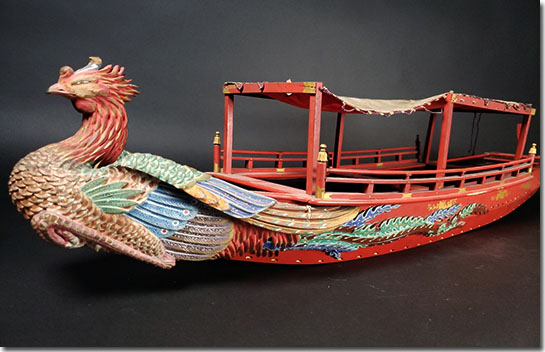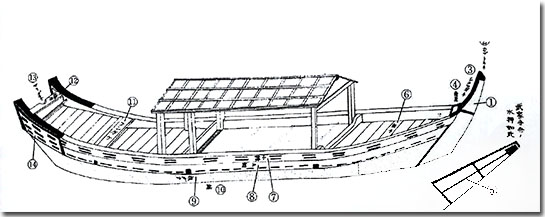Japanese Phoenix Boat Analysis by Adelita Vargas

The Phoenix Boat model (Photo by Adelita Vargas).
On the surface, the Phoenix’s decorated stem post and bright color scheme make the exterior design seem like it was only for aesthetic purposes. However, both the Phoenix and the predominant red color scheme may have been purposefully used for symbolic reasons. The Japanese at the time considered dragons to be strong in water and the waterfowl to be strong against the wind. In placing the two figures together, they created a charm to ensure a safe voyage. Similarly, the phoenix also came to hold cultural significance extending beyond its majestic appearance as it was often used in reference to the Imperial palace. More specifically, the phoenix was reserved to represent the empress while the emperor was denoted as the dragon. The red coloring of the boat could have stemmed from the Japanese’s belief that the color protected the body of the man in power from evil. Altogether, the exterior design of the Phoenix was potentially chosen to not only showcase the status of the Imperial palace, but also how they sought to protect it.

Dragon- head boat in use in a garden (Image from Jiro Takei and Marc Keane, Sakuteiki: Visions of the Japanese Garden (New York: Tuttle Pub, 2011), 26-27.)
During the Heian period (794-1185) in Kyoto, Japan, the artificial production of gardens and the use of boating in such places was a popular pastime. Pleasure boats, however, became a luxury item accessible only to the aristocrats and the Imperial palace as only they owned property large enough to create a garden to place a boat in. Thus, vessels like the Phoenix were often spotted floating across rivers or streams located in aristocratic households, while also seen in festivals held in the Imperial palace. For aristocrats who wished to take part in this cultural development, they first had to create streams from surrounding rivers and wellsprings. Consequently, developers used a three percent slope when creating these streams to achieve a gentle flow and therefore, creating a peaceful atmosphere and ideal condition for smooth sailing. Though sightseeing was one purpose for boating, the Imperial palace often used Dragon head boats, as seen in the illustration, to float musicians across the pond slowly during festivals as a source of entertainment.

Hiyoke-bune or Shaded Boat (Image from Noboru Kawana, Kinsei nihon no kawabune kenkyu: Kinsei kasen suiunshi. (Tokyo: Nihon Keizai Hyōronsha, 2003), 456).
The Phoenix boat was suspected to have been constructed in Japan approximately 600 years ago and used by noblemen at the time. Historically, people of this social class were considered of high status for their wealth and positions in power, suggesting that the Phoenix boat was most likely constructed for aesthetic purposes and leisure activities. The boat’s structural features, such as its propulsion, flat bottom, and superstructure were all characteristics parallel to those of a Hiyoke-bune (shaded boat). In the case of the Phoenix, a single Japanese sculling oar was used for propulsion, suggesting that only a single rower was required, and that speed was not a priority. Additionally, the boat’s flat bottom enables it to sit along the surface of the water and therefore, is not ideal for harsh waters. Most notably, the Phoenix had a 6-post house, hinting at its purpose to provide shade or protection from the rain. Together, these stylistic choices enable the passenger to experience a smooth ride across rivers while observing the cherry blossom trees and scenery.
Previous Next







